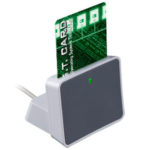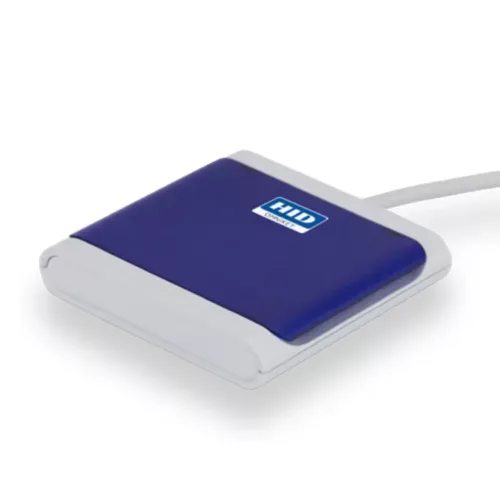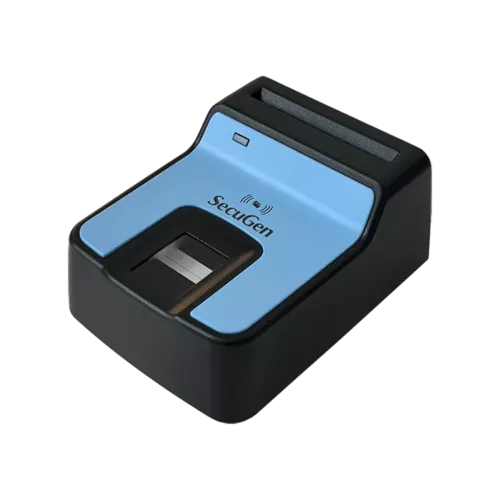A smart card reader is a device that is used to read a smart card. A smart card is a plastic badge that incorporates an installed coordinated circuit that can be either a safe micro-controller or a
Smart Card Reader Types
Smart card readers are available in either contact, contactless, or a combination of contact and contactless models called dual-interface card readers.
Contact smart card readers require that the card is manually inserted into the reader by the user. This application is most commonly used for applications that require more security, like government IDs (National ID, drivers license, Personal Identity Verification (PIV), e-commerce transactions, campus IDs, secure network login, vending, meal plans, loyalty, electronic cash, and health care cards (insurance, electronic medical records / EMR) and border crossing cards.
Contactless smart card readers operate with a radio frequency such as NFC or RFID that communicates when the smart card comes close to the reader. The card does not physically have to be put onto or into the actual reader. Contactless card readers offer the added convenience and speed of not having to insert the card into a reader. The most common applications for contactless card readers include door and facility physical access control (PACS), ePassports, parking, vending, and tollbooth fares.
Smart card readers can be found in the following form:
- Some keyboards have a built-in card reader.
- External devices and internal drive bay card reader devices exist for personal computers (PC).
- Embedded card readers in a kiosk, ATM and vending machine.
- Some laptop models contain a built-in smart card reader and/or utilize flash upgradeable firmware.
- Point-of-Sale (POS) terminals used to read EMV credit cards and debit cards.
External devices that can read a Personal identification number (PIN) or other information may also be connected to a keyboard (usually called “card readers with PIN pad”). This model works by supplying the integrated circuit on the smart card with electricity and communicating via protocols, thereby enabling the user to read and write to a fixed address on the card.
Communication
Smart cards can come with different communication protocols, voltages and frequencies, in order for a card reader to communication with the smart card it needs to the right communication parameters. Most modern smart card readers have the ability to communicate with multiple types of cards, this is called auto-negotiation. A card reader can auto-negotiate with a smart card by trying different combination of protocols, voltages and frequencies, or it can use a smart card ATR (Answer-to-Reset) output that conveys information about the communication parameters. Older readers or embedded proprietary card readers don’t often have the ability to auto-negotiate, typically the communication parameters is controlled by software or middleware (API). Here are a list of communication protocols:
| Name | Description |
|---|---|
| I²C | Serial communication interface with a bidirectional two-wire synchronous serial bus |
| SPI | Serial peripheral interface with four wire-based full-duplex communication protocol |
| T=0 | Asynchronous half-duplex byte-level transmission protocol, defined in ISO/IEC 7816-3 |
| T=1 | Asynchronous half-duplex block-level transmission protocol, defined in ISO/IEC 7816-3 |
| T=2 | Reserved for future use |
| T=3 | Reserved for future use |
| T=CL (Contactless) | APDU transmission via contactless interface ISO/IEC 14443 |
If the card does not use any standard transmission protocol, but uses a custom/proprietary protocol, it has the communication protocol designation T=14.
Memory cards typically use I²C protocol, microprocessor cards such as Java Cards and the MIFARE DESFire use either T=0, T=1 or T=CL and the SPI protocol is typically used for proprietary applications.
Data transfers between smart card and smart card reader
In the context of smart cards, an Application Protocol Data Unit (APDU) is the communication unit between a smart card reader and a smart card. The structure of the APDU is defined by ISO/IEC 7816-4 Organization, security and commands for interchange. There are two types of APDU, ones which send commands and those which transmit answers. The role of the APDU is to allow the communication between the reader and the smartcard and to gather the informations of the smartcard to transmit them to the reader.
Communication between smart card reader and computers
The PC/SC is an interoperability standard ensuring the dialogue between computers and smartcards. This standard is available in most of the operating system, including Windows and Linux. Personal computer/Smart card (or PC/SC) is at the same time a specification and a software library for the access to smartcards under Microsoft Windows. A free implementation of the PC/SC, called PC/SC Lite, is available under GNU/Linux and distributed with Mac OS X. The specification of this library is done by the PC/SC Workgroup, composed of smartcard and computer manufacturer. Its goal is to ensure a standard base of orders to allow a better interoperability between PC, card readers and smartcards.
The latest PC/SC CCID specifications define a new smart card framework. This framework works with USB devices with the specific device class 0x0B. Readers with this class do not need device drivers when used with PC/SC-compliant operating systems, because the operating system supplies the driver by default.
PKCS#11 is an API designed to be platform-independent, defining a generic interface to cryptographic tokens such as smart cards. This allows applications to work without knowledge of the reader details.
Related Products
Related Articles
What Are Security Pass Cards?
Credit Card Encryption: How Does a Security Pass Card Work? Source: https://unsplash.com/photos/bqjswIxbhEE With the introduction of the credit card back in 1966, no one could imagine that security would become such a major factor when using their cards. But
New TOUGHBOOK G2 tablet set to steal the hearts of mobile workers
BRACKNELL, UK. 29th June 2021 – Panasonic today announced the successor to its best-selling fully rugged tablet with the introduction of the TOUGHBOOK G2. Designed with next generation communications, usability and security in mind whilst still providing access to important legacy
Juniper Systems Limited Introduces New Mesa 3 Smart Card Reader for High-Security Industries
BIRMINGHAM, United Kingdom, Feb. 24, 2021 -- Juniper Systems Limited announces its new Mesa® 3 Smart Card Reader. This military-grade, CAC/PIV-compatible smart card reader (SCR) integrates with Juniper’s Mesa 3 Rugged Tablet, providing the ultimate two-tier authentication solution for data protection in
ACS Launches ACR39T-A5 (USB Type C) Smart Card Reader
HONG KONG, 14 December, 2020 — Advanced Card Systems Ltd. (ACS), Asia Pacific's top supplier and one of the world's top 3 suppliers of PC-linked smart card readers (Source: Frost & Sullivan), launches ACR39T-A5. This new addition of ACR39 Series features
Optimize Your Free Trial of Card Encoding Engine (CEE)
Take advantage of free interactive demo software and cards by CardLogix to optimize your free trial From capturing user data to encoding, printing and checking that data, get the most out of your Free Trial of CEE with the
Access-IS integrates with NOVOMATIC
READING, England - Access-IS, the leading provider of identity document readers, is pleased to announce the integration of its ATOM® document reader with the myACP casino management system from NOVOMATIC. The myACP modular system, combined with ATOM, can be


